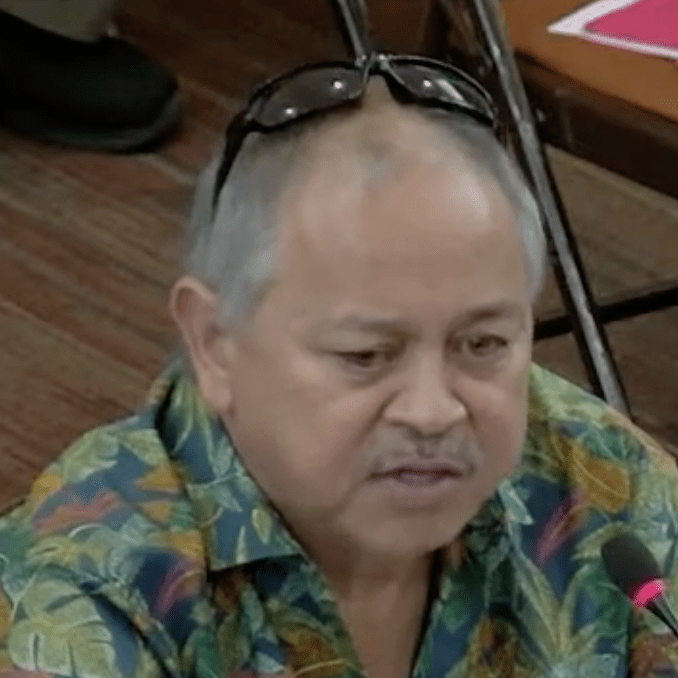It’s been so long, that I kind of forgot how inspiring Eddie Calvo was and how that man genuinely loved the people and did so much to raise people out of poverty. Fifteen years ago that man decided to run for governor with his “Guamanian Dream.”
It was lofty, I remember the critics saying. They said things like, ‘There isn’t anything Calvo could do to fix the economy.’
The first tenet of his Guamanian Dream was that every family would be within reach of homeownership. I have to admit, even I thought that was a tall order. But by the end of his tenure, that governor presided over the development of 6,000 new housing units, much of which was reserved for low- to lower middle-income families. All of that increase to the housing inventory kept both home prices and rents stable throughout his eight years in office.
Those were the days you could buy a 3-bedroom home for $200,000, or rent one for $1,100 a month. Those same homes are nearly double the price today. Good luck finding one for monthly rent below $1,600.
Mr. Calvo engaged federal and private sector “partners” to develop most of Guam’s modern affordable housing projects. He directed the return of thousands of acres of Guam Ancestral Lands properties. The one place where he couldn’t make too significant of inroads was in the leasing of Chamorro Land Trust properties to thousands of applicants still waiting to build their dreams, though hundreds did benefit during his tenure.
About a third of the land in Guam is under the title of the government of Guam, most of which in the inventory of the Chamorro Land Trust Commission. The CLTC since it was enacted in 1975 has had the duty to lease the bulk of those properties to applicants so they could build homes. That application line opened in 1995. Since then, according to CLTC records, close to 3,000 people have received residential leases, while another 10,000 have been waiting for years, if not decades.
The biggest impediment to issuing more leases has been the lack of power, water, and wastewater infrastructure on these properties. Senators for decades have been trying to figure a solution. They created a Chamorro Land Trust Survey and Infrastructure Fund from which a portion of commercial lease payments would be deposited so that one day CLTC can pay for the land surveys and infrastructure needed to lease out these properties. But the money has only been trickling, and is no where near the tens of millions needed to bring power, water, and wastewater connections to these lands.
Two senators are proposing separate though connected legislation that may finally break GovGuam out of its decades-long impasse on the infrastructure problem.

The first bill – Bill No. 179 – by Joe San Agustin will allow the current leaseholders of Guam International Country Club in Dededo to convert the golf course to a solar farm. According to the proposal, GICC and its solar partner would bid on a Guam Power Authority procurement to sell the solar energy produced at the Dededo location into the power system. In exchange, GICC would increase its current annual lease payment for the property and frontload the present market value of that leasehold. The upfront cash payment to the CLTC is estimated to be $9 million.

Bill No. 288 by Therese Terlaje will require that at least half that amount be deposited into the Chamorro Land Trust Survey and Infrastructure Fund, which currently earns the bulk of its cash from cable fees paid to the CLTC. That annual $600,000 is no where near the amounts needed to make a significant impact into the development of water, power, and wastewater infrastructure on the tens of thousands of undeveloped CLTC properties throughout the island.
The $9 million upfront proposed payment from GICC would make an exponentially greater impact, however Ms. Terlaje’s bill would multiply that number. The legislation will change Guam law to allow CLTC to use the survey and infrastructure fund to pay for debt service on low interest loans the CLTC qualifies for through the U.S. Department of Agriculture’s Substantially Underserved Trust Area (SUTA) Initiative.

On a 40-year loan that takes into account the GICC upfront payment, according to local housing expert Carlos Camacho who testified in favor of both bills, the CLTC can get up to $32 million in financing so it can construct the water, wastewater, and power infrastructure needed to get land into the hands of thousands of families.
The San Agustin bill faces opposition and reported back channel attempts to kill the legislation either in the legislature, or if and when it arrives at the governor’s desk. Those opponents are appealing to lawmakers in the name of golf. They are saying they want the Dededo golf course to remain a golf course.
The problem is that without the cash infusion the San Agustin legislation proposes to bring to the CLTC, the Terlaje legislation won’t have the ‘teeth’ to bring in the estimated $32 million in funds that will transform a significant number of undeveloped CLTC lots into ready-to-lease homeownership opportunities for thousands. For everyone else – and especially if there are no other meaningful affordable housing development solutions – that means the pressure on the housing and rental market will continue unaided, keeping prices outside the reach of the average Guamanian.
People who own their homes, or who have pre-pandemic mortgages that are halfway paid may not be able to commiserate with those struggling to afford today’s housing and rental prices. But this is a big deal to thousands of Guamanian families worried about how they can afford to keep a roof over their heads.

Chris Duenas is familiar with Mr. Calvo’s Guamanian Dream. He and I served the former governor’s administration together. The senator is pushing for his colleagues to pass two rather significant housing reform bills that also have the potential to reduce housing costs and to ignite affordable housing development.
The first of the bills, Bill No. 51, will allow adult relatives of a homeowner to construct a separate living area on the same lot. The second, Bill No. 175, will allow a new on-the-lot wastewater treatment technology to be permitted and reduce the current regulation on the building of homes on lots smaller than half an acre on land above the aquifer. Both bills have yet to be reported out by the chairwomen of the committees under which they already have been publicly heard months ago.
As for the San Agustin bill, my fear is that an underhanded desire for control of that land may be at play here, with very influential people coddling certain senators and perhaps even the governor to kill the legislation so that the power-who-always-are can seize the day above the needs of thousands of families struggling to get by.
I’d really like to see the on-floor debate on these bills. I’d like to know – as I’m sure thousands of renters and others needing their own place to live – which senators will argue for golf ahead of affordable housing and the little bit of a break we little people need.
These four bills may very well be the jumpstart to that Guamanian Dream Eddie Calvo left behind when his second term ended. Gross domestic product was never higher than it was in Guam the year that man left office. He had made significant inroads in his fight against poverty.
“Affordable homes are rising throughout our villages,” the former governor told Guamanians in the middle of his tenure. “And we won’t stop until every Guamanian who has a dream of homeownership wakes up in their new bedrooms to the smell of fresh paint and breakfast cooking in the kitchen.”
Mr. Calvo, I can attest, was driven by a desire greater than his want of the everyday Guamanian to be wealthier and more financially fruitful.
“What we are building is measured not by landscape,” he said in his 2014 state of the island address held right across the lot where he rebuilt the Guam Congress Building in Hagatna, “but by innovation and progress. We do not appreciate it simply for its architecture, but for its very essence. Perhaps the best way to express this is in Chamorro: Ciudad gi san’hilo annai todu man’aguaiya. A city of love, where every street is paved with the laughter of children. And every building is teeming with artistry and music. And every home is built with the strength of the family. And every village is pouring with the pride of the people. And every corner of our lives filled with the kindness of neighbors, the romance of lovers, and the embrace of the different and the uplifting of the outcast, and the caring for one another.”
“Look around,” he told the crowd surrounded by the developments he started in his first term in office. “The city is beautiful. So let’s finish building it.”
It isn’t too late to bring back Calvo’s Guamanian Dream and to make it a living call to action for us all.
[The video contained here is of Eddie Calvo delivering his 2014 state of the island address at the Plaza de Espana on February 24, 2014. I produced this video, which was posted onto the governor’s YouTube channel in 2014].






1 Comments
David J. Sablan
05/21/2024 at 9:47 AM
You’re right, Troy. I worked with Gov. Eddie Calvo, in getting affordable homes built when I served on the GHURA Board of Commissioners. That was the directive he game me and my colleagues on the GHURA Board. Truly enjoyed helping his Administration achieve the “Guamanian Dream!”